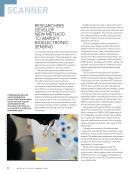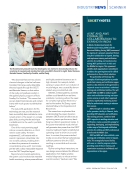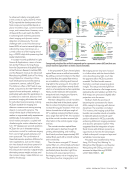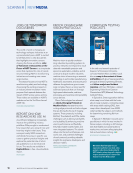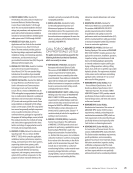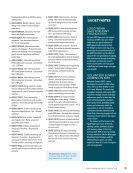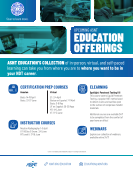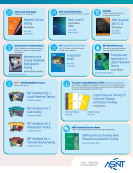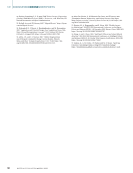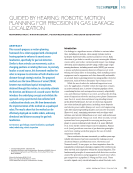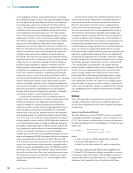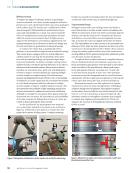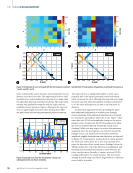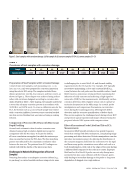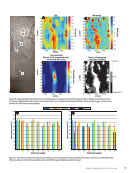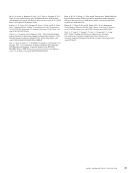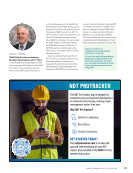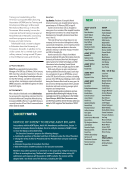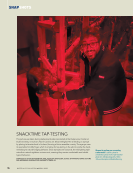capture prey, such as lemmings, burrow-
ing under thick snowpack [58, 59]. The
exceptional acoustic sensing abilities of
these animals result from a combination
of external ears and coordinated motion
of the pinna, head, and body known as
head tilting (see Figure 4). This allows
for multitasking in binaural hearing
(acoustic sensing using only two ears).
However, limited research has been con-
ducted on how their external ears and
head-tilting strategies affect sound local-
ization in the acoustic field, particularly
when detecting low-amplitude sounds
beneath packed snow. The aye-aye and
termite perform active acoustic-based
testing, actively generating vibroacous-
tic cues to detect and characterize their
environment, while the fox engages in
passive acoustic-based foraging by lis-
tening to movements and noises during
its search for prey. One of the most
promising applications for such tasks is
underground leakage detection. Gaining
insights into this process could result in
the development of advanced noncon-
tact acoustic sensing technologies for
subsurface leakage inspections, using
binaural acoustic sensing. The funda-
mental principle of aeroacoustics leak
detection revolves around the generation
and propagation of sound waves when
gas escapes from a pipeline [60]. One
of the main drawbacks of this sensing
modality is its reduced sensitivity as the
sensors move further away from the
acoustic source due to significant atten-
uation [61]. Traditionally, an array of
microphones has been used to increase
the SNR and enable effective source
localization through beamforming tech-
niques [62]. However, this technique
generates a substantial amount of data,
which is not ideal for the development of
an automated leak detection platform as
well as a digital twin approach in infra-
structure monitoring. Fortunately, this
issue has been ingeniously addressed by
biological systems such as red and arctic
foxes utilizing only two ears (binaural
sensing). Instead of relying on an
increased number of sensors to enhance
sensitivity, these biological systems
evolved external ear (pinna) shapes to
act as hardware for amplifying sound
from specific directions, a capability
further complemented by the strategic
motion and control of the pinna and
head (e.g., head tilting). This approach
could revolutionize applications such as
leak detection or human localization in
rescue missions.
The three examples mentioned are
just a few among many species that
potentially perform processes similar to
NDT/E methods. Such bioinspiration
can lead to the development of new
technologies or the evolution of existing
ones, enhancing the reliability and sensi-
tivity of NDT/E methods.
2.4. Bioinspiration Impact on
NDT Education and Workforce
Development
One of the challenges we face as instruc-
tors and researchers in the field of
NDT/E is attracting students, as we often
compete with more visibly appealing
fields like robotics and data science,
which the younger generation perceives
as more attractive career paths. However,
bioinspiration offers a unique opportu-
nity to help attract students to the field
of NDT/E. The integration of bioinspired
concepts not only allows us to pioneer
new NDE technologies that can make
our world safer, but also serves as a
compelling tool to engage and attract
students. By highlighting the innovative
intersection between nature and tech-
nology, educators can increase student
involvement in NDT/E, bringing fresh
talent into the field and encouraging the
next generation of NDT/E professionals.
3. Conclusions
These three biological examples—
aye-ayes, termites, and foxes—are
among millions of species that use pro-
cesses remarkably similar to those we
conduct in the NDT/E fields. Through
evolution, these species have developed
highly specialized sensory systems for
survival processes such as foraging for
food, avoiding predators, and communi-
cating for mating. In many cases, these
functions are analogous to detecting
defects, characterizing materials, and
assessing environmental conditions—all
achieved without disrupting their sur-
roundings. By studying these biological
systems and in particular the processes,
for example tap-scanning, we can gain
valuable insights and inspiration for
advancing NDT technologies. The pre-
cision and efficiency seen in “nature’s
NDE specialists” offer promising avenues
for pioneering more adaptive, autono-
mous, and efficient NDT/E technologies,
particularly in challenging environments.
Furthermore, bioinspiration provides an
engaging platform for NDT/E education
and workforce development, attract-
ing younger generations to the field of
NDT/E and fostering the next wave of
innovation as well as keeping the world
a safer place to live.
As we continue to identify and
explore new “nature’s NDE special-
ists,” the potential for revolutionary
advancements in robotics, sensing,
and materials—specifically focused
on NDT/E and material characteriza-
tion processes—becomes increasingly
Figure 4. Red fox
head tilting.
A P R I L 2 0 2 5 • M AT E R I A L S E V A L U AT I O N 31
CREDIT:
KERRY
HARGROVE
ing under thick snowpack [58, 59]. The
exceptional acoustic sensing abilities of
these animals result from a combination
of external ears and coordinated motion
of the pinna, head, and body known as
head tilting (see Figure 4). This allows
for multitasking in binaural hearing
(acoustic sensing using only two ears).
However, limited research has been con-
ducted on how their external ears and
head-tilting strategies affect sound local-
ization in the acoustic field, particularly
when detecting low-amplitude sounds
beneath packed snow. The aye-aye and
termite perform active acoustic-based
testing, actively generating vibroacous-
tic cues to detect and characterize their
environment, while the fox engages in
passive acoustic-based foraging by lis-
tening to movements and noises during
its search for prey. One of the most
promising applications for such tasks is
underground leakage detection. Gaining
insights into this process could result in
the development of advanced noncon-
tact acoustic sensing technologies for
subsurface leakage inspections, using
binaural acoustic sensing. The funda-
mental principle of aeroacoustics leak
detection revolves around the generation
and propagation of sound waves when
gas escapes from a pipeline [60]. One
of the main drawbacks of this sensing
modality is its reduced sensitivity as the
sensors move further away from the
acoustic source due to significant atten-
uation [61]. Traditionally, an array of
microphones has been used to increase
the SNR and enable effective source
localization through beamforming tech-
niques [62]. However, this technique
generates a substantial amount of data,
which is not ideal for the development of
an automated leak detection platform as
well as a digital twin approach in infra-
structure monitoring. Fortunately, this
issue has been ingeniously addressed by
biological systems such as red and arctic
foxes utilizing only two ears (binaural
sensing). Instead of relying on an
increased number of sensors to enhance
sensitivity, these biological systems
evolved external ear (pinna) shapes to
act as hardware for amplifying sound
from specific directions, a capability
further complemented by the strategic
motion and control of the pinna and
head (e.g., head tilting). This approach
could revolutionize applications such as
leak detection or human localization in
rescue missions.
The three examples mentioned are
just a few among many species that
potentially perform processes similar to
NDT/E methods. Such bioinspiration
can lead to the development of new
technologies or the evolution of existing
ones, enhancing the reliability and sensi-
tivity of NDT/E methods.
2.4. Bioinspiration Impact on
NDT Education and Workforce
Development
One of the challenges we face as instruc-
tors and researchers in the field of
NDT/E is attracting students, as we often
compete with more visibly appealing
fields like robotics and data science,
which the younger generation perceives
as more attractive career paths. However,
bioinspiration offers a unique opportu-
nity to help attract students to the field
of NDT/E. The integration of bioinspired
concepts not only allows us to pioneer
new NDE technologies that can make
our world safer, but also serves as a
compelling tool to engage and attract
students. By highlighting the innovative
intersection between nature and tech-
nology, educators can increase student
involvement in NDT/E, bringing fresh
talent into the field and encouraging the
next generation of NDT/E professionals.
3. Conclusions
These three biological examples—
aye-ayes, termites, and foxes—are
among millions of species that use pro-
cesses remarkably similar to those we
conduct in the NDT/E fields. Through
evolution, these species have developed
highly specialized sensory systems for
survival processes such as foraging for
food, avoiding predators, and communi-
cating for mating. In many cases, these
functions are analogous to detecting
defects, characterizing materials, and
assessing environmental conditions—all
achieved without disrupting their sur-
roundings. By studying these biological
systems and in particular the processes,
for example tap-scanning, we can gain
valuable insights and inspiration for
advancing NDT technologies. The pre-
cision and efficiency seen in “nature’s
NDE specialists” offer promising avenues
for pioneering more adaptive, autono-
mous, and efficient NDT/E technologies,
particularly in challenging environments.
Furthermore, bioinspiration provides an
engaging platform for NDT/E education
and workforce development, attract-
ing younger generations to the field of
NDT/E and fostering the next wave of
innovation as well as keeping the world
a safer place to live.
As we continue to identify and
explore new “nature’s NDE special-
ists,” the potential for revolutionary
advancements in robotics, sensing,
and materials—specifically focused
on NDT/E and material characteriza-
tion processes—becomes increasingly
Figure 4. Red fox
head tilting.
A P R I L 2 0 2 5 • M AT E R I A L S E V A L U AT I O N 31
CREDIT:
KERRY
HARGROVE











